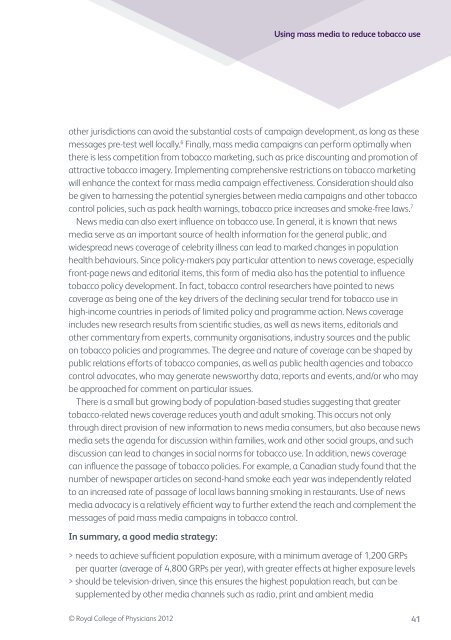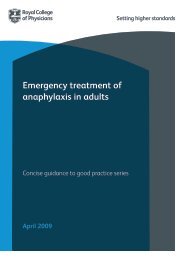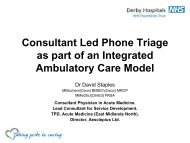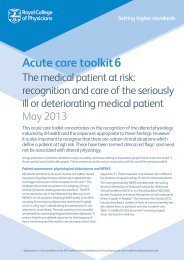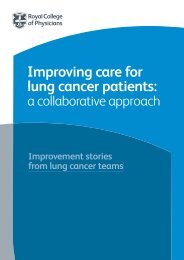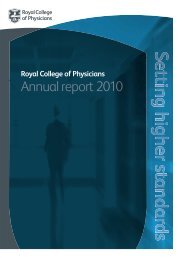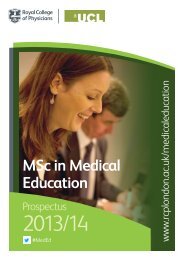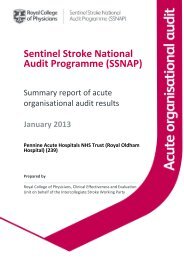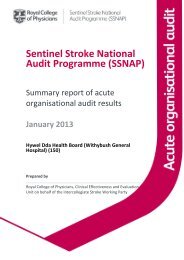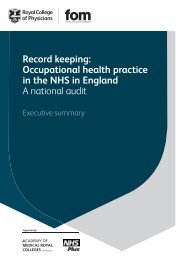Fifty years since Smoking and health - Royal College of Physicians
Fifty years since Smoking and health - Royal College of Physicians
Fifty years since Smoking and health - Royal College of Physicians
Create successful ePaper yourself
Turn your PDF publications into a flip-book with our unique Google optimized e-Paper software.
Using mass media to reduce tobacco use<br />
other jurisdictions can avoid the substantial costs <strong>of</strong> campaign development, as long as these<br />
messages pre-test well locally. 6 Finally, mass media campaigns can perform optimally when<br />
there is less competition from tobacco marketing, such as price discounting <strong>and</strong> promotion <strong>of</strong><br />
attractive tobacco imagery. Implementing comprehensive restrictions on tobacco marketing<br />
will enhance the context for mass media campaign effectiveness. Consideration should also<br />
be given to harnessing the potential synergies between media campaigns <strong>and</strong> other tobacco<br />
control policies, such as pack <strong>health</strong> warnings, tobacco price increases <strong>and</strong> smoke-free laws. 7<br />
News media can also exert infl uence on tobacco use. In general, it is known that news<br />
media serve as an important source <strong>of</strong> <strong>health</strong> information for the general public, <strong>and</strong><br />
widespread news coverage <strong>of</strong> celebrity illness can lead to marked changes in population<br />
<strong>health</strong> behaviours. Since policy-makers pay particular attention to news coverage, especially<br />
front-page news <strong>and</strong> editorial items, this form <strong>of</strong> media also has the potential to infl uence<br />
tobacco policy development. In fact, tobacco control researchers have pointed to news<br />
coverage as being one <strong>of</strong> the key drivers <strong>of</strong> the declining secular trend for tobacco use in<br />
high-income countries in periods <strong>of</strong> limited policy <strong>and</strong> programme action. News coverage<br />
includes new research results from scientifi c studies, as well as news items, editorials <strong>and</strong><br />
other commentary from experts, community organisations, industry sources <strong>and</strong> the public<br />
on tobacco policies <strong>and</strong> programmes. The degree <strong>and</strong> nature <strong>of</strong> coverage can be shaped by<br />
public relations efforts <strong>of</strong> tobacco companies, as well as public <strong>health</strong> agencies <strong>and</strong> tobacco<br />
control advocates, who may generate newsworthy data, reports <strong>and</strong> events, <strong>and</strong>/or who may<br />
be approached for comment on particular issues.<br />
There is a small but growing body <strong>of</strong> population-based studies suggesting that greater<br />
tobacco-related news coverage reduces youth <strong>and</strong> adult smoking. This occurs not only<br />
through direct provision <strong>of</strong> new information to news media consumers, but also because news<br />
media sets the agenda for discussion within families, work <strong>and</strong> other social groups, <strong>and</strong> such<br />
discussion can lead to changes in social norms for tobacco use. In addition, news coverage<br />
can infl uence the passage <strong>of</strong> tobacco policies. For example, a Canadian study found that the<br />
number <strong>of</strong> newspaper articles on second-h<strong>and</strong> smoke each year was independently related<br />
to an increased rate <strong>of</strong> passage <strong>of</strong> local laws banning smoking in restaurants. Use <strong>of</strong> news<br />
media advocacy is a relatively effi cient way to further extend the reach <strong>and</strong> complement the<br />
messages <strong>of</strong> paid mass media campaigns in tobacco control.<br />
In summary, a good media strategy:<br />
> needs to achieve suffi cient population exposure, with a minimum average <strong>of</strong> 1,200 GRPs<br />
per quarter (average <strong>of</strong> 4,800 GRPs per year), with greater effects at higher exposure levels<br />
> should be television-driven, <strong>since</strong> this ensures the highest population reach, but can be<br />
supplemented by other media channels such as radio, print <strong>and</strong> ambient media<br />
© <strong>Royal</strong> <strong>College</strong> <strong>of</strong> <strong>Physicians</strong> 2012 41


